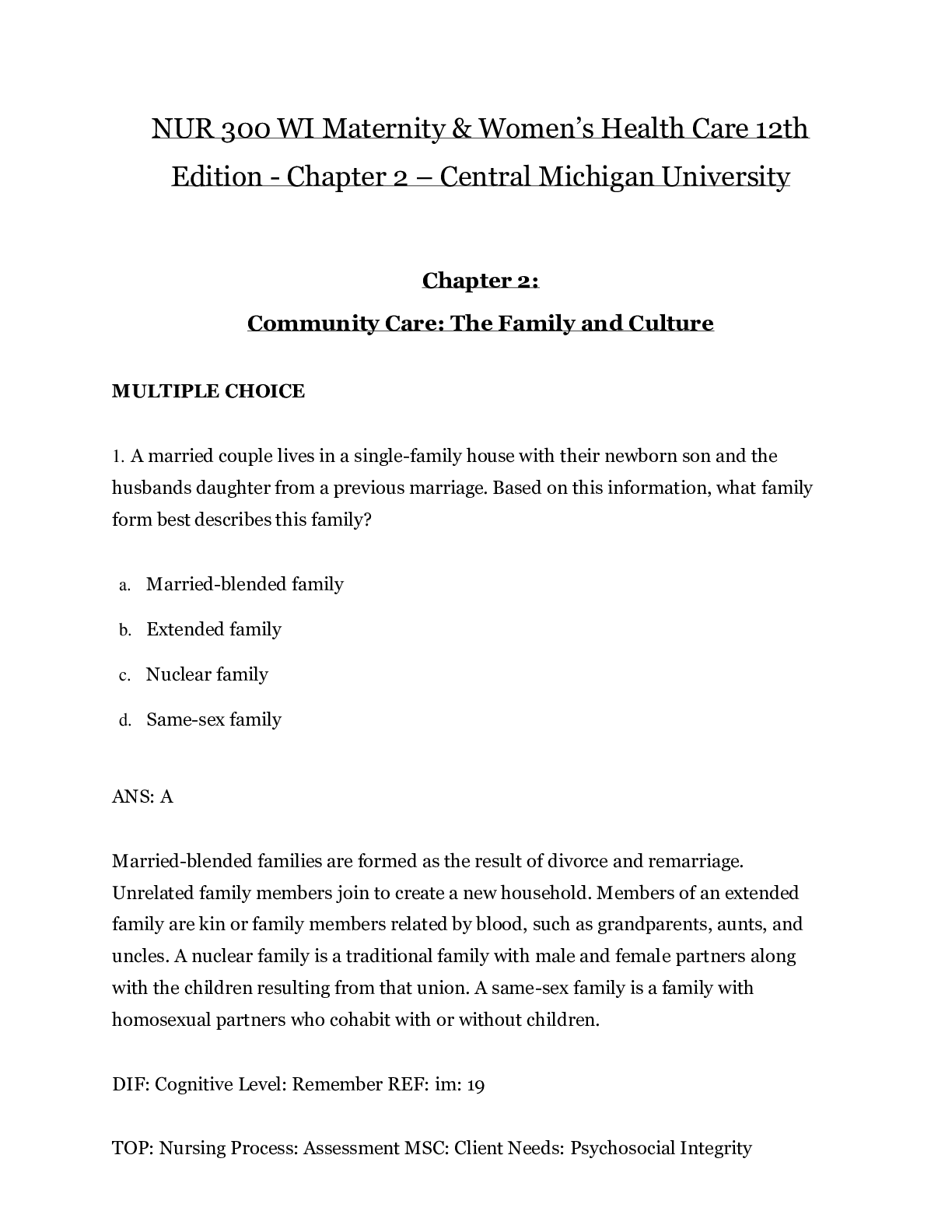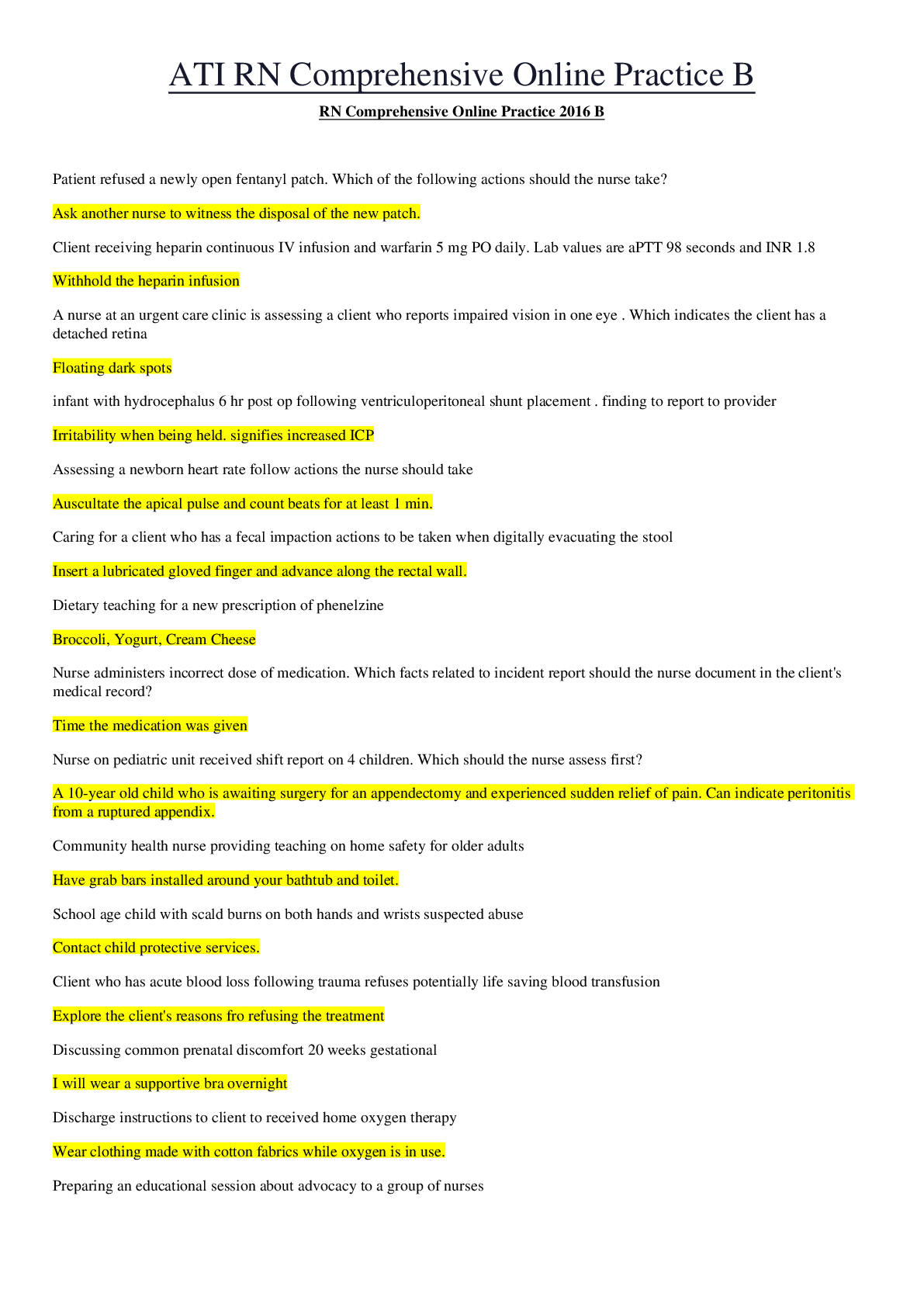*NURSING > EXAM > NUR 300 WI Maternity & Women’s Health Care 12th Edition (2019/2020) - Chapter 2 – Central Michig (All)
NUR 300 WI Maternity & Women’s Health Care 12th Edition (2019/2020) - Chapter 2 – Central Michigan University | Community Care: The Family and Culture
Document Content and Description Below
NUR 300 WI Maternity & Women’s Health Care 12th Edition - Chapter 2 – Central Michigan University Chapter 2: Community Care: The Family and Culture MULTIPLE CHOICE 1. A married couple ... lives in a single-family house with their newborn son and the husbands daughter from a previous marriage. Based on this information, what family form best describes this family? a. Married-blended family b. Extended family c. Nuclear family d. Same-sex family Married-blended families are formed as the result of divorce and remarriage. Unrelated family members join to create a new household. Members of an extended family are kin or family members related by blood, such as grandparents, aunts, and uncles. A nuclear family is a traditional family with male and female partners along with the children resulting from that union. A same-sex family is a family with homosexual partners who cohabit with or without children. DIF: Cognitive Level: Remember REF: im: 19 TOP: Nursing Process: Assessment MSC: Client Needs: Psychosocial Integrity 2. Which key factors play the most powerful role in the behaviors of individuals and families? a. Rituals and customs b. Beliefs and values c. Boundaries and channels d. Socialization processes Beliefs and values are the most prevalent factors in the decision-making and problem-solving behaviors of individuals and families. This prevalence is particularly true during times of stress and illness. Although culture may play a part in the decision-making process of a family, ultimately, values and beliefs dictate the course of action taken by family members. Boundaries and channels affect the relationship between the family members and the health care team, not the decisions within the family. Socialization processes may help families with interactions within the community, but they are not the criteria used for decision making within the family. DIF: Cognitive Level: Understand REF: pp. 21-22 TOP: Nursing Process: Planning MSC: Client Needs: Psychosocial Integrity 3. Using the family stress theory as an interventional approach for working with families experiencing parenting challenges, the nurse can assist the family in selecting and altering internal context factors. Which statement best describes the components of an internal context? a. Biologic and genetic makeup b. Maturation of family members c. Familys perception of the event d. Prevailing cultural beliefs of society The family stress theory is concerned with the familys reaction to stressful events. Internal context factors include elements that a family can control such as psychologic defenses, family structure, and philosophic beliefs and values. The family stress theory focuses on ways that families react to stressful events. Maturation of family members is more relevant to the family life-cycle theory. The family stress theory focuses on internal elements that a family might be able to alter. DIF: Cognitive Level: Understand REF: im: 21 TOP: Nursing Process: Diagnosis MSC: Client Needs: Psychosocial Integrity 4. The nurse is developing a plan of care for a Hispanic client who just delivered a newborn. Which cultural variation is most important to include in the care plan? a. Breastfeeding is encouraged immediately after birth. b. Male infants are typically circumcised. c. Maternal grandmother participates in the care of the mother and her infant. d. Bathing is encouraged immediately after delivery. In the Hispanic family, the expectant mother is strongly influenced by her mother or mother-in- law. Breastfeeding is often delayed until the third postpartum day. Hispanic male infants are not usually circumcised. Bathing after delivery is most often delayed. DIF: Cognitive Level: Apply REF: im: 26 TOP: Nursing Process: Planning MSC: Client Needs: Psychosocial Integrity 5. Which health care service represents a primary level of prevention? a. Immunizations b. Breast self-examination (BSE) c. Home care for high-risk pregnancies d. Blood pressure screening Primary prevention involves health promotion and disease prevention activities to reduce the occurrence of illness and enhance the general health and quality of life. This level of care includes, for example, immunizations, using infant car seats, and providing health education to prevent tobacco use. BSE is an example of secondary prevention that involves early detection of health problems. Home care for a high-risk pregnancy is an example of tertiary prevention. This level of care follows the occurrence of a defect or disability. Blood pressure screening is anexample of secondary prevention and is a screening tool for early detection of a health care problem. DIF: Cognitive Level: Understand REF: im: 34 TOP: Nursing Process: Implementation MSC: Client Needs: Health Promotion and Maintenance 6. What is the primary difference between hospital care and home health care? a. Home care is routinely and continuously delivered by professional staff. b. Home care is delivered on an intermittent basis by professional staff. c. Home care is delivered for emergency conditions. d. Home care is not available 24 hours a day. Home care is generally delivered on an intermittent basis by professional staff members. The primary difference between health care in a hospital and home care is the absence of the continuous presence of professional health care providers in a clients home. In a true emergency, the client should be directed to call 9-1-1 or to report to the nearest hospitals emergency department. Generally, home health care entails intermittent care by a professional who visits the clients home for a particular reason and provides on-site care for periods shorter than 4 hours at a time. DIF: Cognitive Level: Understand REF: pp. 34-35 TOP: Nursing Process: Implementation MSC: Client Needs: Safe and Effective Care Environment 7. To provide culturally competent care to an Asian-American family, which question should the nurse include during the assessment interview? a. Do you prefer hot or cold beverages? b. Do you want some milk to drink? c. Do you want music playing while you are in labor? d. Do you have a name selected for the baby? Asian-Americans often prefer warm beverages. Milk is usually excluded from the diet of this population. Asian-American women typically labor in a quiet environment. Delaying naming the child is not uncommon for Asian-American families. DIF: Cognitive Level: Apply REF: im: 27 TOP: Nursing Process: Assessment MSC: Client Needs: Physiologic Integrity 8. The womans family members are present when the nurse arrives for a postpartum and newborn visit. What should the nurse do? a. Observe the family members interactions with the newborn and one another. b. Ask the woman to meet with her and the baby alone. c. Perform a brief assessment on all family members who are present. d. Reschedule the visit for another time so that the mother and infant can be privately assessed. The nurse should introduce her or himself to the client and to the other family members who are present. Family members in the home may be providing care and assistance to the mother and infant. However, this care may not be based on sound health practices. Nurses should take the opportunity to dispel myths while family members are present. The responsibility of the home care maternal-child nurse is to provide care to the new postpartum mother and to her infant, not to all family members. The nurse can politely ask about the other people in the home and their relationships with the mother. Unless an indication is given that the woman would prefer privacy, the visit may continue. DIF: Cognitive Level: Analyze REF: im: 35 TOP: Nursing Process: Assessment MSC: Client Needs: Psychosocial Integrity 9. What is a limitation of a home postpartum visit? a. Distractions limit the nurses ability to teach. b. Identified problems cannot be resolved in the home setting. c. Necessary items for infant care are not available. d. Home visits to different families may require the nurse to travel a great distance. One limitation of home health visits is the distance the nurse must travel between clients. Driving directions should be obtained by telephone before the visit. The home care nurse is accustomed to distractions but may request that the television be turned off so that attention can be focused on the client and her family. Problems cannot always be resolved; however, appropriate referrals may be arranged by the nurse. The nurse is required to bring any necessary equipment, such as a thermometer, baby scale, or laptop computer, for documentation. DIF: Cognitive Level: Understand REF: im: 35 TOP: Nursing Process: Planning MSC: Client Needs: Safe and Effective Care Environment 10. During the childbearing experience, which behavior might the nurse expect from an African- American client? a. Seeking prenatal care early in her pregnancy b. Avoiding self-treatment of pregnancy-related discomfort c. Requesting liver in the postpartum period to prevent anemia d. Arriving at the hospital in advanced labor African-American women often arrive at the hospital in far-advanced labor and may view pregnancy as a state of wellness, which is often the reason for the delay in seeking prenatal care. African-American women practice many self-treatment options for various discomforts of pregnancy. African-American women may also request liver in the postpartum period, which is based on a belief that liver has a higher blood content. DIF: Cognitive Level: Understand REF: im: 26 TOP: Nursing Process: Assessment MSC: Client Needs: Health Promotion and Maintenance 11. Which resource best describes a health care service representing the tertiary level of prevention? a. Stress management seminars b. Childbirth education classes for single parents c. BSE pamphlet and teaching d. Premenstrual syndrome (PMS) support group A PMS support group is an example of tertiary prevention, which follows the occurrence of a defect or disability (e.g., PMS). Stress management seminars are a primary prevention technique for preventing health care issues associated with stress. Childbirth education is a form of primary prevention. BSE information is a form of secondary prevention, which is aimed toward early detection of health problems. DIF: Cognitive Level: Understand REF: im: 28 TOP: Nursing Process: Implementation MSC: Client Needs: Psychosocial Integrity 12. When the services of an interpreter are needed, which is the most important factor for the nurse to consider? a. Using a family member who is fluent in both languages b. Using an interpreter who is certified, and documenting the persons name in the nursing notes c. Directing questions only to the interpreter d. Using an interpreter only in an emergency Using a certified interpreter ensures that the standards of care are met and that the information exchanged is reliable and unaltered. The name of the interpreter should be documented for legal purposes. Asking a family member to interpret may not be appropriate, although many health care personnel must adopt this approach in an emergency. Furthermore, most states require that certified interpreters be used when possible. When using an interpreter, the nurse should direct questions to the client. The interpreter is simply a means by which the nurse communicates with the client. Every attempt should be made to contact an interpreter whenever one is needed. During an emergency, health care workers often rely on information interpreted by family members. This information may be private and should be protected under the rules established by the Health Insurance Portability and Accountability Act (HIPAA). Furthermore, family members may skew information or may not be able to interpret the exact information the nurse is trying to obtain. DIF: Cognitive Level: Apply REF: pp. 24, 25 TOP: Nursing Process: Implementation MSC: Client Needs: Psychosocial Integrity 13. Which traditional family structure is decreasing in numbers and attributable to societal changes? a. Extended family b. Binuclear family c. Nuclear family d. Blended family The nuclear family has long represented the traditional American family in which husband, wife, and children live as an independent unit. As a result of rapid changes in society, this number is steadily decreasing as other family configurations are socially recognized. Extended families involve additional blood relatives other than the parents. A binuclear family involves two households. A blended family is reconstructed after divorce and involves the merger of two families. DIF: Cognitive Level: Understand REF: im: 18 - - - - - - - - - - - - - - - - - - - - - - - - - - - - - - - - - - - - a. The walking survey determines how much exercise an expectant mother has been getting, to help her make health care decisions. b. The walking survey usually takes place on the maternity ward but can be expanded to other areas of the hospital. c. The walking survey is a method of observing the resources and health-related environment of the community. d. The walking survey is performed by government census takers as part of their canvas. The walking survey is a valuable tool for the nurses in the community and has nothing to do with exercise. It is an observational method used to assess the health environment of the community. A walking survey takes place in the community, not the maternity ward, and is not part of the census; it is conducted by nurses in the community. DIF: Cognitive Level: Remember REF: IMS: 30 TOP: Nursing Process: Assessment MSC: Client Needs: Health Promotion and Maintenance 28. A Native-American woman gave birth to a baby girl 12 hours ago. The nurse notes that the woman keeps her baby in the bassinet except for bottle feeding and states that she will wait until she gets home to begin breastfeeding. The nurse recognizes that this behavior is most likely a reflection of what? a. Delayed attachment b. Embarrassment c. Disappointment in the sex of the baby d. Belief that babies should not be fed colostrum Native Americans often use cradle boards and often avoid handling their newborn. They also believe that the infant should not be fed colostrum. Delayed attachment is a developmental concern, not a cultural belief. Embarrassment is not likely the cause for a delay in the initiation of breastfeeding and should be explored further by the nurse. The mother may voice her disappointment that the infant is a girl; however, this would rarely cause her to delay breastfeeding and would exhibit itself in other ways. DIF: Cognitive Level: Understand REF: IMS: 27 TOP: Nursing Process: Assessment MSC: Client Needs: Psychosocial Integrity [Show More]
Last updated: 2 years ago
Preview 1 out of 32 pages

Buy this document to get the full access instantly
Instant Download Access after purchase
Buy NowInstant download
We Accept:

Reviews( 0 )
$10.50
Can't find what you want? Try our AI powered Search
Document information
Connected school, study & course
About the document
Uploaded On
Jun 28, 2020
Number of pages
32
Written in
Additional information
This document has been written for:
Uploaded
Jun 28, 2020
Downloads
0
Views
93








 – University of the People.png)

















